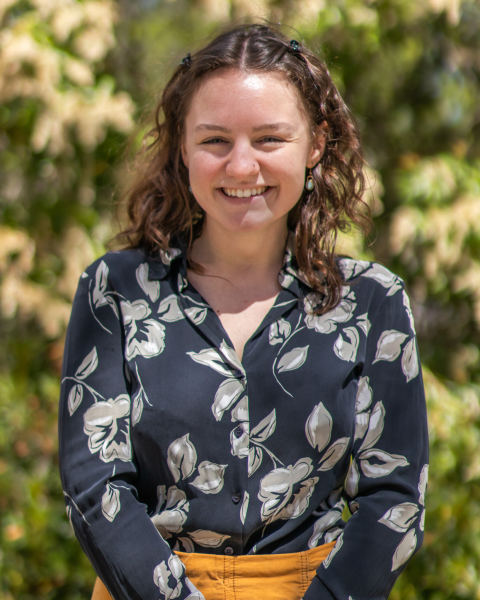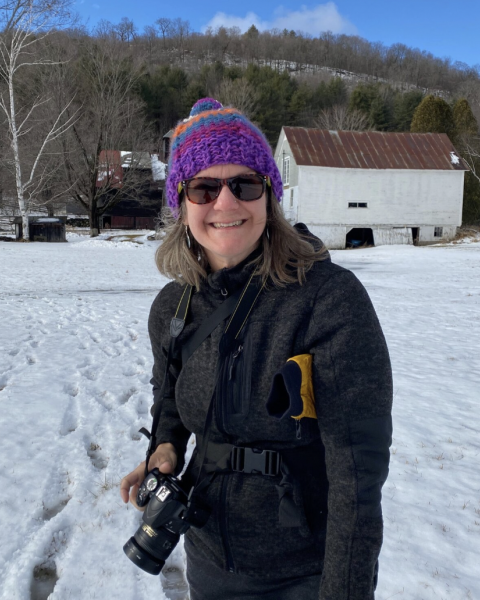Rising Tides in New Hampshire’s Fishing Industry
This interview is part of the NH Food Alliance’s and Ink + Light Creative’s Field Photos Project, a photo-interview series telling the story of New Hampshire’s vibrant and diverse food system. Explore more from the Field Photos Project here >>
NH Community Seafood (NHCS) was founded in 2013 by Sarah Vanhorn, a New Hampshire Sea Grant fellow of the Brian E. Doyle Fellowship, and Joshua Wiersma, Sector XI manager. Andrea Tomlinson came splashing in with experience in aquaculture, seafood sales and community development work two years after establishment in 2015.
NH Community Seafood is a multi stakeholder cooperative, with a diverse team of fisherfolk who collaborate tirelessly to connect local seafood directly from fishermen to the public. All NHCS fish and shellfish is caught sustainably, fileted and delivered to one of NHCS's 20 pick up locations across New Hampshire and Massachusetts, and picked up by participating Community Supported Fishery shareholders to enjoy.
I spoke with Andrea about NHCS, who, like many in the fishing industry, struggles with the “graying of the fleet” phenomenon. Because of strict industry regulations, financial expenses, and high capital requirement, younger folks are not replacing the fishermen who retire. This challenges small, local fisheries to compete against large, industrialized operations. For the past seven years, Andrea has walked the line as an environmentalist, a sustainable aquaculture advocate, and a fisheries advocate. Now she is transitioning into the role of Founder and Executive Director of the New England Young Fishermen’s Alliance to tackle the struggling industry head-on.


Daisy Young (DY): Tell me a little about the organization: what inspired you to work in this field? How did you get started?
Andrea Tomlinson (AT): NH Community Seafood (NHCS) is something called a multi-stakeholder cooperative— a for-profit, community-supported, and restaurant-supported fishery— it’s a big mouthful. The Community Supported Fishery (CSF) world developed in the early 2000s. Actually, our first official CSF in the US was in Port Clyde up in Maine, just above Brunswick, called Port Clyde Fresh Catch. They started the concept of getting local seafood into the consumer’s hands directly from the harvest.
NHCS started in 2013, it was the brainchild of Sarah Vanhorn. She was getting her Masters at UNH and she was an NH Sea Grant Brian E. Doyle fellow. Then we had a guy named Joshua Wiersma. Prior to starting NHCS with Sarah, he was sector manager, he came in as the sector manager, he was getting his Ph.D. in fisheries. A sector is a group of fishermen who combine their quota on their permits to fish it collectively. So he and Sarah started this wonderful organization, which was very grassroots at the time.
I got involved through my friend and former boss, Chris Duffy. Because I, unlike most fisheries people, also have an aquaculture background. A lot of wild-caught fisheries people are really anti-aquaculture because they feel it’s threatening both the real estate in the ocean and their product sales. But it’s really great to have this diverse background. I used to be an aquaculture fish culturist, I was the Broodstock Manager over at Great Bay Aquaculture. Chris Duffy was my former boss there and he became a board member for NHCSF. In 2015, he suggested I apply for the General Manager job at NHCSF because, unfortunately, Great Bay Aquaculture closed in 2013. So I applied. It was between me and two other men. I got the job and there I was for seven years.
DY: Why are Community Supported Fisheries (CSF) so important?
AT: Community Supported Fisheries are so important because—this is a commonly quoted fact—70-90% of the seafood that we eat in the United States is imported. Then conversely, depending on the state, between 70-90% of the seafood that’s caught in the state is then exported out of the state. This supply chain is very dysfunctional. The whole idea of eating within your ecosystem and eating seafood that is caught on or near your shores obviously supports the local environment, it supports the local economy, it directly supports the fishermen, and it supports the working waterfronts which are endangered throughout the United States.
The other piece with NHCS that I should mention is that we offered a 50-cent incentive to all our Fishermen Shareholders, as a patronage payment on each pound of fish that we bought directly from the fishermen. So when you are purchasing from us, you’re not only supporting a local industry, you’re giving them a higher price for their product just by purchasing from a CSF.
On the Restaurant Supported Fishery (RSF) side, there are restaurants, retailers, and boutique-type grocery stores that sell local goods. When restaurants are buying local seafood, we love when they can put the name of the boat, the captain, and where it was landed on the board. This is an anomaly for my generation and my mother’s generation. If you go back one more generation, that’s what they were used to.
DY: What is the motivation to raise awareness to the public about where their food is coming from?
AT: I’ve spoken to so many members, some of our stakeholders or consumer-shareholder members, who are in their 70s—our demographic for the shareholders is older—who have a nostalgic connection of going down to the docks and getting the fish directly from the fishermen. That’s how it used to be.
We lost that, we lost that cultural connection with modernization and industrialization. I was always trying to bring back the old adage of ‘the catch of the week,’ connecting with your roots, culture, and heritage of New England. I feel it’s really important for people to connect with our New England heritage and culture. That goes beyond colonialism because we all know that Native Americans were catching fish, in quantity, before White colonists came here. I think it’s a real connection with your sense of place, where you live and how you purchase food affects your local economy.
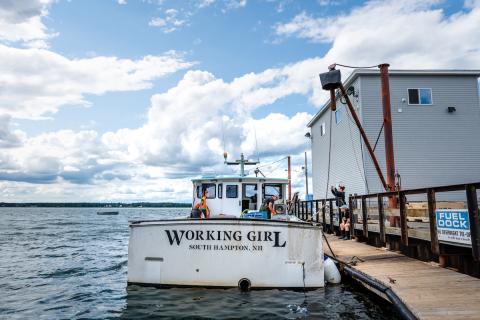

DY: I’d love to shift to talk about the past couple of years. What obstacles arose out of the pandemic?
AT: When COVID first hit: panic. Because I thought to myself, how are we going to do all of these pickup locations? Some of them are self-serve and it’s all face-to-face. Just to give you an idea, we have several pickup locations at local farm stores like Emery Farm in Durham. We pushed through the obstacle of how we were going to convince people to come to pick up this local seafood and feel safe about it. We implemented masks and I got pretty little sanitizers that Jewell Towne Winery started producing instead of wine. We got those for every pick-up location. Then I had to do a lot of education with my volunteers and my pick-up locations, so there was a lot of shifting around, which everyone was doing in the food-service business. But then there was this apparent need to increase the local fishermen’s business.
Other obstacles were how to distribute safely, how to educate the public on ‘Hey, now more than ever, this is the time to support your local fishermen. They need you.’ They didn’t have an outlet for their seafood. This was now my time to educate them on the pathetically dysfunctional supply food chain that our United States seafood goes through. We took it and ran with it and it was really a great year.
DY: Tell me more about why business increased during the pandemic. How did you and local fishermen convince the public to support NHCSF?
AT: A lot of exported seafood goes to Canada, casinos, cruise lines, and foodservice chains. As we all know, everything shut down. Although that was an obstacle, we took those lemons and made a huge vat of lemonade with them. In that, we got people to support our local fishermen as we’ve never seen before. I think that was two-fold. It was ‘Gosh, I really need to support my local fishermen and farmers because they need me’, and ‘I’m scared to go to the grocery store.’ I think we really benefited from people wanting to consolidate their food purchases in tandem with wanting to support their local farmers and fishermen. We had the best sales we ever had in 2020.
We also assisted with some direct-to-consumer sales models for NHCSF. It was ironically the sternmen, the guys who work on the back of the boats. Their captains are 50 years plus with no interest in doing direct-to-consumer sales. They are out there fishing for ten hours and they don’t want to come in and deal with the public. They want to offload, go home, get a good dinner, and go to bed by 8:00 pm, ‘cause they’re up at 4:00 am. But the youngbloods were like ‘Hey boss, we should start selling these lobsters off the back of the boat right in the parking lot!’ We saw three or four young fishermen doing that with huge success. We assisted NH Sea Grant in putting together some materials on how to do direct marketing during the pandemic and some simple graphics for fishermen to look at and refer to. This was a wonderfully challenging time.
DY: Do you think that this engagement from the public and consumers will continue as we come out of the pandemic?
AT: Oh, the question of the century! I think what happened is as people started going back to grocery stores—and the typical venues where they would get food from—we saw less support, but I think the outreach and education stuck. Does that necessarily drive peoples’ purchasing habits? Not always, but I’m very optimistic, so I like to think that if anything, we brought the discrepancy in the amount of imported seafood that’s eaten as opposed to our local seafood to the attention of seafood consumers, which is absolutely fantastic. There’s a lot of talk in the local food world right now on how to keep that momentum we saw from COVID going or even uplift it. But of course, you can kind of compare last summer to a non-COVID summer because it was wide open until that spike at the end. It was very frustrating, budgeting for 2021, because you know you’re not going to get that COVID support you got in 2020. I did a budget for 80% of the business we got in 2020 and we didn’t even get that in 2021. It was disappointing. Humans support a cause, and then it gets back to normal, and they forget their altruistic, philosophical reasons for why they were doing what they were doing.
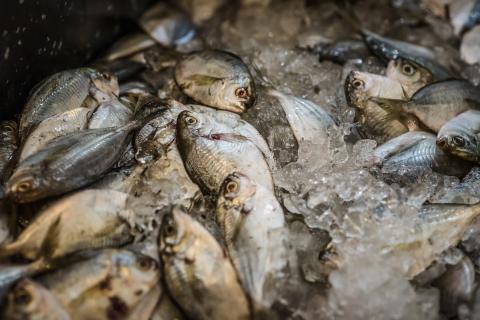
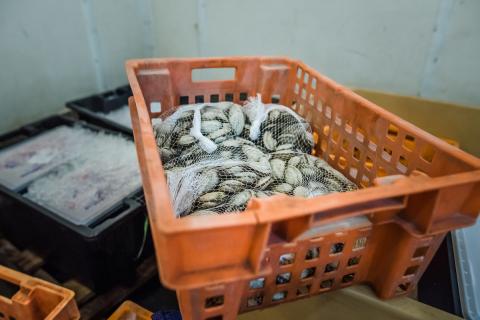
DY: It’s clear the fishing industry and the local fishing industry comes with a lot of challenges even outside of something like a pandemic. Can you talk about some of the other industry challenges that NHCSF has faced?
Oh boy, how long do you have? Just in my seven years at NHCS, I saw four veteran captains retire, and no young captains take their place. The term “succession” is when someone retires from their trade and one of their family members takes over the business. We’re not seeing that in the fishing industry any more. It’s being called the “graying of the fleet,” and it is a worldwide phenomenon. We’ve seen this issue with several trades as well; I know several tradesmen who say they have such a hard time recruiting young men or women into the trades.
For the fishing industry, I can speak to why we’re not seeing a lot of successions and next-gen involvement. It is the endless, laborious, complex regulations that are unfortunately put upon fishermen through the National Marine Fisheries Service (NMFS) which falls under National Oceanic and Atmospheric Association (NOAA). The regulatory hierarchy goes: Department of Commerce, NOAA, the National Marine Fisheries Service, and then the New England Fisheries Management Council. We have eight different councils throughout the country and they are the last and final organization that vote on and enforce fisheries regulations these organizations go through. Their job is to ask for industry input, delegated by Council members that are selected and appointed industry professionals and elect industry professionals to help and develop and implement industry regulations with regulations, hire people to do studies on scallop and fish populations, etc. I am a pretty smart gal, and when I look at the topics and resolutions of a New England Fisheries Council meeting, it’s so complex and so dynamic. It’s really hard to follow. So that is a deterrent.
Then the biggest deterrent— the fishing industry now hates NOAA and the National Marine Fisheries Council. They feel that they are not listening to them, they feel that they’re trying to move towards the consolidation of big corporate boats and not small boats. When I say the industry, I mean small to medium-sized boats that I deal with—our biggest boat is about 52 feet in the fleet that NH Community Seafood buys from.
Another huge obstacle for young people getting into the industry is the cost. It’s a quarter of a million-dollar investment minimum, for a lobsterman or a ground fisherman or woman to get into the industry. That’s the cost of the boat and the permit. You hope the boat comes with equipment—I’m talking about a used boat, not a new boat. The capital requirement is ridiculously unattainable. This is why I started New England Young Fishermen’s Alliance, because these guys who are steadfast and staying in the industry, regardless of all this negativity, they’re still saying ‘Listen, this is in my blood this is what I want to do. I’ve tried other trades, I’ve tried going back to school, trade school, community college.’ I’ve got so many stories, but it’s in their blood. Once you get fishing in your blood, it’s in your blood, that’s all you’re doing. I can relate, because I’m a little tomboy that used to go fishing all the time in Jersey, and I could not wait to get a boat and fish. I lived and looked forward to it, I get it.
But when you say to a young person working on the back of a boat who is 28 or 29 and just starting a family, ‘Hey you’re going to have to get a loan for about 250,000 grand to get a boat and permit,’ they say ‘What? I don’t even own a house yet! My wife’s pregnant with her second kid, I’m behind on my taxes, how am I supposed to do that?’ That’s the problem. If we do not solve this problem, what my aquaculture colleagues have said, wildlife fisheries will be a boutique item by 2050 and we will be eating all farm-raised seafood if we don’t get more fishermen in the industry.
I’m a fisheries advocate, but at the same time I have a strong background in research science. I'm an environmentalist, so I’m trying to bridge the gap. There’s a big gap between regulators and the industry, and I want to build a bridge that we all walk across, and everyone listens to everyone else. It’s a big, big job—and I think I can do it.
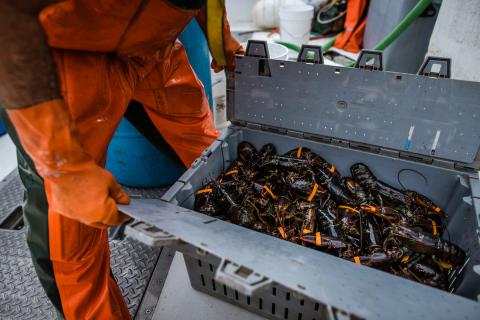
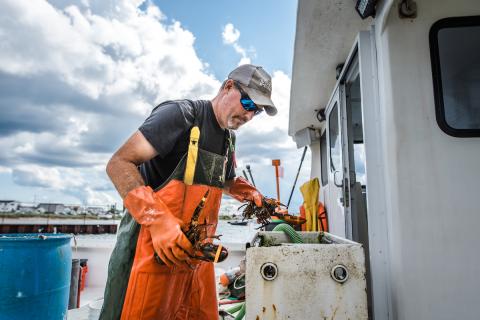
DY: I’m happy to hear you talk about women in the fishing industry because that’s something I wanted to know more about. What do you think the barriers are for women in the industry? How do we build more gender equity when most fisherfolk are men?
AT: Traditionally, fishing has only been men. But ironically, it’s the women running the show. I have seen this in Jamaica where I used to live and volunteer, I know it happens all over Africa, too. When the catch comes in, it’s typically the girlfriend, the wife, the sister, or the daughter who manages the business. It’s the man doing the hunting and gathering, and the female managing the money. Let’s not forget that.
To be a woman in the fishing industry, you have to work twice as hard as men, and then you’re still not quite getting the full respect that you should be getting even then. I’ve always worked with mostly men because I’m not in academia, I’m in the industry. I have found that it has been disparagingly skewed towards the male attitude. I have been sexually discriminated against my whole life and it’s very frustrating. What I do is put on my grundens (foul weather gear) and I go out with the fishermen. I ask ‘Can I help you guys pick the net and spend the day with you?’ And that’s how I earn my respect. I go out there with a hook and I start picking fish out of the net and they realize I can actually do this.
It’s discouraging because what we’re seeing more and more is that there are more women in marine policy than I have ever seen in my lifetime, but fewer women fishing. Right now, I have an 18-year-old applying for the Deckhand to Captain training program, and I cannot encourage her enough. I have another colleague I work with, Jillian Robillard, who runs Southern Maine Crabs. She’s 23 years old and owns her own crab broker business—amazing. So what I try to do as a woman in the industry is single them out and give them tons of support and promotion, ‘cause they need it.
There's been a lot of talk about equity within all kinds of food systems since George Floyd and there’s tons of money to incorporate equity into your systems and I’m very delighted by that. In my neck of the world, I’m just trying to encourage every woman I know who might be ideal for this training program to get into it. And I’m trying to encourage every woman I know to come to meetings. We really need more women to get into the industry and encourage younger women that it’s something they can do.
DY: I’d love to check in about your replacement, Joe Rankin, and where he is at with NHCSF. Specifically where you see his past experience taking NHCSF since your own experience shaped your role so much.
AT: I advertised the [General Manager] job and was accepting resumes along with Gabby Bradt. When his resume came in I thought ‘That’s our guy. He’s young, he’s only 31.’ And he has his own shellfish farm, so he understands shellfish. He’s on his way to getting his Masters in Business Administration, which makes him an amazing candidate. He used to work at the Seacoast Science Center, so for that reason, we checked off the outreach and education experience that is necessary for this position. He was a manager of Island Creek Oyster Farms, so he had managerial experience in delegating and managing employees, which is also necessary for this job because you can manage up to three employees at a time plus an intern. Joe really has what it takes to do this. I have full confidence in him. He’s actually waiting on a text from me right now because I am advising him on what to do and how to do it without being too bossy!
What impresses me about Joe is that he even applied to it that young, that he had the guts to apply, I give it to him. He looks like he walked out of an L.L. Bean magazine. Aesthetically he fits the part of the NHCS leader. He’ll be fine. I was exactly like this my first year too. ‘Oh my god, there are so many moving parts to this—how am I going to make this work?’ But he’ll be fine and I’ll be right there for him. He’s going to be great.
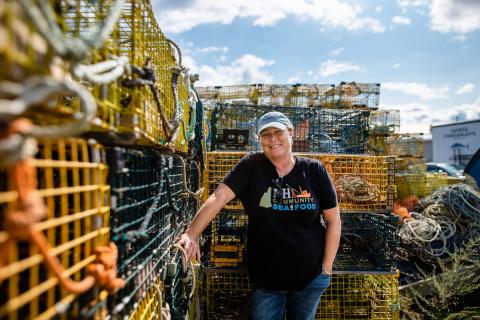
DY: Let’s talk about the future. Imagine NH Community Seafood is thriving in ten years. What would achievements look like within the New Hampshire region?
AT: What it would look like to me is that we would have community supported fishery pick-ups throughout the entire state. We would cover the seafood desert areas like the North Country, North Conway, and the Hanover-Lebanon area. We need to branch out with more availability of seafood within the state. We certainly need more marketing money.
What I haven’t mentioned is that in the ‘90s, there were a hundred groundfishing boats in New Hampshire and now we are down to six. Six boats fishing for fish! This is obscene. We need more fish fishermen out there. We need regulations to soften a little bit and we need NOAA— which mandates National Marine Fisheries Service policies—to provide subsidies for entry-level captains for the price of the expensive permits they need to get into the game. That would encourage NHCS and New England Young Fishermen's Alliance to work together. That’s my big plan, that’s my big vision: to work together to get more seafood throughout the state. And then develop pickup locations in Maine and Massachusetts.
We can grow if we have statewide support, the infrastructure in place, and the marketing budget. That’s how I envision it. Our big mission, which I didn’t mention yet, is to promote underutilized species here in New England. The cod got cut so dramatically right when we started. We want to promote what used to be called ‘trash fish.’ We aren’t going to call them trash fish, we’re going to call them underutilized species. That’s my vision: people start eating local fish and shellfish, talking it up, and it becomes super popular. Then we diminish or at least reduce the seafood imports.
DY: So if an individual were to ask you ‘Why eat local?’ how would you answer? What is one thing every individual can do to support their local foodshed and economy?
AT: I would say because every purchase of local seafood is supporting New England’s local fishermen, a workforce that is an endangered species. You’re not only supporting our economy, but you’re supporting a trade that is part of our culture and our heritage.
They can purchase local seafood, even twice a year. Try it! Try something different. Be adventurous. That’s the thing with seafood, people are so hesitant to cook it because they think they don’t know how to cook it. They don’t like their kitchen smelling like fish—give me a break, open a window, put on your hood fan. I’ve got an answer for all of these excuses. There are air fryers now, they cook fish amazingly. I had air-fried Haddock last night from last year’s season. Amazing! Just a little bit of seasoning, I put some Old Bay on it, and then I did some cornmeal from Tuckaway Farm in Lee, NH, and I cooked it up in the air fryer for 15 minutes. It was amazing.
DY: What message do you have for food network partners across New Hampshire?
AT: My message to network partners is we have to all keep working together to promote New Hampshire food. Just like I’m on this national group called the National Seafood Council Task Force, started by the Seafood Nutrition Partnership that’s promoting Americans to eat more seafood. That group is imported, wild-caught, farm-raised—it’s everybody. We in the New Hampshire food system have got to come together and have a collective branding strategy and a collective marketing strategy to get New Hampshire people to support New Hampshire food producers and harvesters. Alaska does that with seafood, so do North Carolina, Virginia, Louisiana. Think about how many times you’ve seen something promoting Maryland crab! When groups with all of this knowledge and marketing know-how come together, with a collective message, it’s very powerful, and it reaches a lot of people.
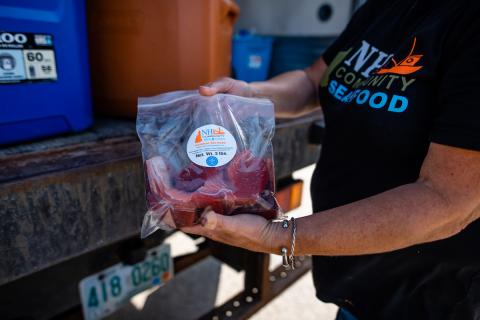
To sign up for one of NH Community Seafood’s various fish shares and shellfish shares, check out their website and follow along on Facebook and Instagram for updates and recipes. To learn more about the New England Young Fishermen’s Alliance, read this article from Seacoast Online and stay tuned for more details on developments on their Facebook and Instagram.
This interview has been edited for clarity and length.


